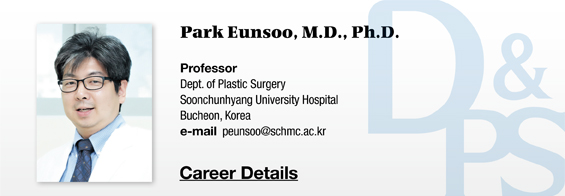▶ Previous Artlcle : #14-1. Understanding and Application of Epidermal Growth Factors
EGF is a powerful stimulator of differentiation of various cells including epidermal cells and fibroblasts. In animal studies, EGF is shown to promote regeneration of porcine epidermis and rabbit corneal epithelium. It accelerates the wound healing process by increasing the tension in the wound site, promoting protein synthesis such as fibronectin, and migration of epidermal cells. Epithelial cells contain large amounts of EGFR. EGFR is also found in endothelial cells, fibroblasts and smooth muscle cells. EGF does not promote collagenesis but increases the number of fibroblasts and thereby indirectly induces collagenesis which in turn strengthens the wound site. Besides effects on epithelium and re-epithelization, it is also involved in vascularization and collagenase action.
[Advertisement] Ultra Skin/Pastelle – Manufacturer: WONTECH(www.wtlaser.com)]
In the nervous system, EGF is expressed in various cells and carry out multitude of functions. EGF is found in the embryonic stage as well as after birth. EGF mRNA is found throughout the brain including brainstem, cerebellum, cerebral cortex, hippocampus and thalamus. Its expression is most noticeable in the neural groove.
Considering its action of stimulating growth of neural precursor cells isolated from the fetal midbrain, adult striatum, and retina, it is expressed in the germinal zone of the brain related to development and promotes neuronal regrowth. Injection of EGF into murine brain results in proliferation of neural stem cells such as FGF-2. It also increases the number of stem cells in test-tube culture. Moreover, EGF is known to accelerate the division of neuroglia. In lower densities, EGF promotes neuroglia division, however, in higher concentrations, it has the opposite action of promoting cell differentiation. Thus, EGF acts as a modulator and growth factor of various cells in the central nervous system including neurons or neuroglia.
As briefly mentioned earlier, advances in bioengineering allows gene recombination and cloning which in turn made mass production of EGF possible. Since 1983, recombinant human EGF (rhEGF) has been mass produced using recombination of human EGF gene expressed in microorganisms.
rhEGF is a bioengineered version of the human EGF. EGF gene is injected into microorganisms to promote production of EGF. EGF protein is isolated and purified to enable mass production. rhEGF in a polypeptide form restores the pace of skin regeneration by modulating the proliferation rate of epidermal cells. rhEGF triggers cell proliferation and differentiation by binding to EGFR to activate tyrosine kinase on the receptor surface.
Efficacy of EGF can be summarized as following.
First, EGF is found in rich concentrations in the saliva, urine, breast milk, tears and blood, etc. When a wound is sustained, it is delivered to the wound site through blood and activates the healing process. It has various actions other than promotion of wound healing.
Second, along with FSH (Follicle Stimulation Hormone) that promotes secretion of female hormones, EGF is involved in maturation of the fertilized egg in the uterus. Third, it helps regeneration of cornea which lacks blood vessels and therefore is susceptible to degeneration. Fourth, it promotes proliferation of epithelial and endothelial cells. Fifth, EGF promotes proliferation of fibroblasts that play a key role in collagenesis. Sixth, it induces secretion of regenerative factors that are involved in neovascularization in damaged skin. Seventh, it promotes synthesis of fibronectin that organizes the skin tissues and forms a protective matrix.
EGF is a cell growth factor that exists in the skin and plays a crucial role of accelerating wound healing, maintenance of elasticity and stabilization of damaged skin. EGF enters the epidermal cells and acts on the nucleus to promote division and proliferation rate of the epidermal cells. It modulates the division and proliferation rate of epidermis and regeneration of the dermis to control the overall process of skin regeneration.
Generally, wrinkles form due to gradual reduction of EGF and slower regeneration of cells and metabolism past the age of 25. Healthy, young skin has the regeneration cycle of 28 days but beyond the age of 25, this cycle is lengthened to 6 weeks. The regenerative power of the skin is weakened and stratum corneum is thickened, which triggers the aging process. Provision of EGF to aging skin can help restore its youthfulness and growth of new cells in the skin. Therefore, cosmetic products containing EGF are being actively developed.
When a wound is sustained, the human body naturally provides EGF and other growth factors to the injury site to restore the healthy condition. If the endogenous production of EGF is inadequate, it should be provided from external sources to help the healing process. With proven effects on various wounds, application of EGF is widening to include diabetic foot ulcer, wound, cornea damage, abdominal incision, aesthetic dermabrasion, anti-aging procedure, stomach ulcer and burn care, etc.
References
❶ Brown G, Curtsinger L, Brightwell J, Ackerman D, Tobin G, Polk H, et al. Enhancement of epidermal regeneration by biosynthetic epidermal growth factor. J Exp Med. 1986;163(5): 1319-1324. ❷Cohen I, Crossland M, Garrett A, Diegelmann R. Topical application of epidermal growth factor onto partial-thickness wounds in human volunteers does not enhance reepithelialization. Plast Reconstr Surg. 1995;96(2):251-254. ❸ Brown G, Nanney L, Griffen J, Cramer A, Yancey J, Curtsinger L, et al. Enhancement of wound healing by topical treatment with epidermal growth factor. N Engl J Med. 1989;321(2): 76-79. ❹ Nanney L. Epidermal and dermal effects of epidermal growth factor during wound repair. J Invest Dermatol. 1990;94(5): 624-629. ❺ Breuing K, Andree C, Helo G, Slama J, Liu P, Eriksson E. Growth factors in the repair of partial thickness porcine skin wounds. Plast Reconstr Surg. 1997;100(3): 657-664. ❻ Hong JP, Jung HD, Kim YW. Recombinant human epidermal growth factor (EGF) to enhance healing for diabetic foot ulcers. Ann Plast Surg. 2006;56: 394-398. ❼Hong JP, Kim YW, Jung HD, Jung KI. The effect of various concentrations of human recombinant epidermal growth factor on split-thickness skin wounds. Int Wound J. 2006;3: 123-130.
-To be continued-
▶ Next Artlcle : #15-1. Cell therapy with human allogeneic keratinocytes





















